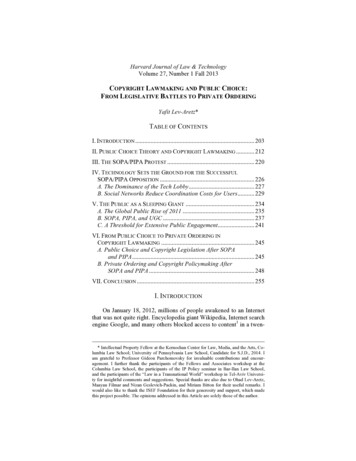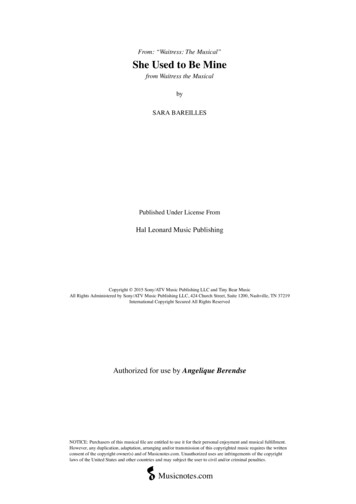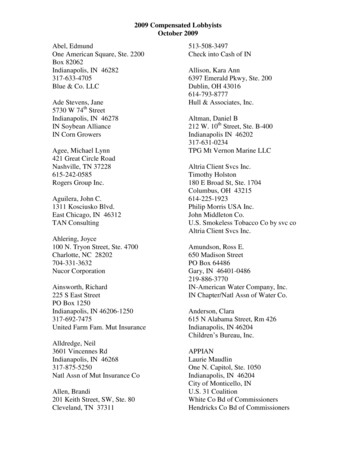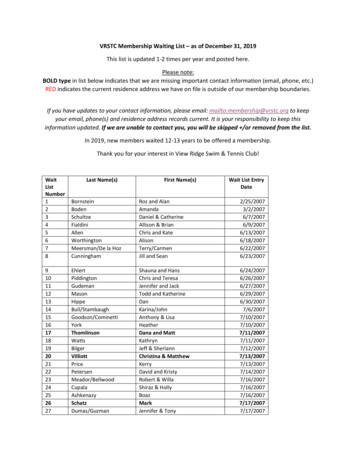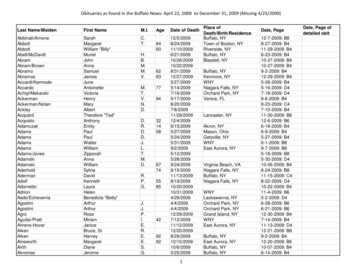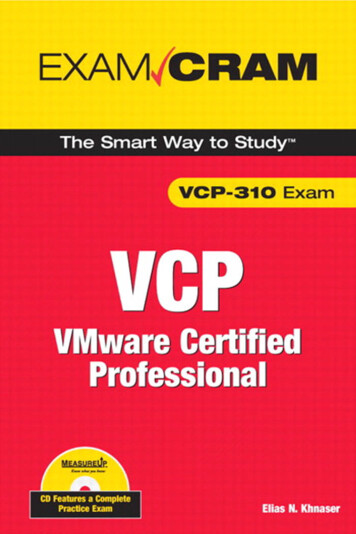
Transcription
VCP Exam Cram, VMware Certified ProfessionalCopyright 2009 by Que PublishingAll rights reserved. No part of this book shall be reproduced, stored in a retrieval system, or transmitted by any means, electronic, mechanical, photocopying, recording, orotherwise, without written permission from the publisher. No patent liability isassumed with respect to the use of the information contained herein. Although everyprecaution has been taken in the preparation of this book, the publisher and authorassume no responsibility for errors or omissions. Nor is any liability assumed for damages resulting from the use of the information contained herein.ISBN-13: 978-0-7897-3805-9ISBN-10: 0-7897-3805-8Library of Congress Cataloging-in-Publication DataKhnaser, Elias N.VCP exam cram : VMware certified professional / Elias Khnaser.— 1st ed.p. cm.ISBN 978-0-7897-3805-9 (pbk. w/cd)1. Electronic data processing personnel—Certification. 2. Virtual computersystems—Examinations—Study guides. 3. VMware. I. Title.QA76.3.K498 2009005.4’3—dc222008044885Printed in the United States of AmericaFirst Printing: December 2008TrademarksAll terms mentioned in this book that are known to be trademarks or service markshave been appropriately capitalized. Que Publishing cannot attest to the accuracy ofthis information. Use of a term in this book should not be regarded as affecting thevalidity of any trademark or service mark.VMware, the VMware “boxes” logo and design, Virtual SMP, and VMotion are registered trademarks or trademarks (the “Marks”) of VMware, Inc. in the United Statesand/or other jurisdictions. You are not permitted to use the Marks without the priorwritten consent of VMware.Warning and DisclaimerEvery effort has been made to make this book as complete and as accurate as possible, but no warranty or fitness is implied. The information provided is on an “as is”basis. The author and the publisher shall have neither liability nor responsibility to anyperson or entity with respect to any loss or damages arising from the information contained in this book or from the use of the CD or programs accompanying it.Bulk SalesQue Publishing offers excellent discounts on this book when ordered in quantity forbulk purchases or special sales. For more information, please contactU.S. Corporate and Government or sales outside of the U.S., please contactInternational Sales sociate PublisherDavid DusthimerAcquisitions EditorBetsy BrownDevelopment EditorAndrew CuppManaging EditorPatrick KanouseSenior ProjectEditorTonya SimpsonCopy EditorChuck HutchinsonIndexerKen JohnsonProofreaderWater CrestPublishingTechnical EditorsChris HussJoseph NogaThomas ReichPublishingCoordinatorVanessa EvansBook DesignerGary AdairCompositionGina Rexrode
PrefaceVirtualization is one of the hottest topics in the tech industry today. The leaderin the virtualization space at the present time is without a doubt VMware withits virtual infrastructure offering. As VMware software began to take its place inthe data center and demand respect in the industry, the need for a certificationpath became clear. Such a certification separates those who have studied thetechnology and can apply it at a professional level from those who have justinstalled it and started messing with it. I am a big believer that there is no alternative to studying a technology thoroughly. There is only so much you can learnfrom installing it and using it in only a few specific circumstances, because thatexposes you only to limited features and obscures you from harnessing the fullpotential of the software by leveraging features you probably never knew existed. For this reason and many more, I am a strong believer that you should studythe software, learn it, and then use it hands on as much as possible. It is by doingthis that you truly master the software.When you have studied and understand a software, taking a certification exambecomes relatively easy. For example, if you’ve thoroughly studied, you knowthat the maximum amount of physical memory that ESX 3.5 supports is 256GB.However, someone who just installs the software and starts using it may notknow this because the software installation does not require this knowledge atthe time of installation.This book aims to present the information you need to recap and reinforce yourexisting knowledge of VMware Infrastructure 3 and properly prepare you toconfidently take the VCP-310 exam. The book is structured in a way to help youwith your final exam preparation and contains enough information to make it atrue test preparation book, but in a concise manner.
IntroductionWelcome to the VCP Exam Cram. The purpose of this book is to properly prepare you and equip you with the needed knowledge to successfully sit and passthe VCP-310 exam. Here, we provide a general overview of the VMware certification program and discuss how this Exam Cram book will help you reach yourgoals of becoming certified.This book, as with its predecessors in the Exam Cram family of certificationbooks, concentrates on reinforcing your knowledge of the subject matter athand and preparing you to sit the exam. That being said, this book will not teachyou everything there is to know about the technology because this is not its primary purpose. We instead concentrate on the material that is most likely toappear on the test.Before you dive in head first into the information provided, we recommend youtake the self-assessment that immediately follows this introduction. This selfassessment will help you evaluate your knowledge of the VMware material bothin the real world and under ideal exam circumstances.Based on the results of the self-assessment, you may feel that additional education is necessary. Numerous resources are available, including. Official VMware-authorized training. VMware Infrastructure 3: Install& Configure V3.5 is the ideal course for the VCP exam. VMware product documentation and technical white papers are availableat http://www.vmware.com. VMware VI3: ESX Server 3.5 & VC 2.5 Training DVD by EliasKhnaser goes in depth on the subject matter and is a great way to learnagain and again at your own pace. See http://www.eliaskhnaser.com. Other books, including Mastering VMware Infrastructure 3 by ChrisMcCain, are also excellent resources on the subject.Although reading a book is an excellent way of learning, we strongly recommend that you take the knowledge you acquire from book learning and use it toinstall and configure VMware ESX Server and VirtualCenter. Hands-on experience is imperative not only to your successful completion of the exam, but alsoto your successful endeavors in properly implementing and maintaining an ESXenvironment.
4VCP Exam Cram, VMware Certified ProfessionalAbout the VMware VCP ProgramThe VMware VCP program was designed to allow candidates to demonstratetheir expertise with the software by completing certain requirements and passing an exam. The program is open to any individuals who complete the requirements. There are many advantages to becoming VCP certified. For some, it willbe for career advancement; for others, it will be to become VMware partners,and so on.The requirements set forth by VMware on becoming a VCP are as follows:. Attend a VMware authorized course. These instructor-led courses pro-vide a great learning method and hands-on exposure to the product. Gain hands-on experience with the product. Sit and pass the VCP-310 exam to demonstrate your expertise on thematter.VMware also provides various documents on its website that help you gain abetter understanding of the topics that you will be challenged on during theexam. I would like to single out the VI3 Exam blueprint as a great reference forthe exam.Taking a VMware Certification ExamAs of this writing, VMware Education requires you to attend a VMware-authorized training class to fulfill your eligibility on becoming a VMware CertifiedProfessional (VCP). After you have attended the VMware-authorized class andhave completed your preparations for taking the exam, you need to register at aVMware testing center in your area. Currently, all VMware certification examsare administered by Pearson VUE. You can register online at http://www.pearsonvue.com/vmware or by calling 1-800-676-2797 in the United States andCanada. Outside the Americas, please consult the Pearson VUE website forcontact information in your region of the world.The VCP-310 exam costs 175 USD and must be booked at least 24 hours inadvance. You may reschedule your exam up to 24 hours before the date youintend on taking it. Cancellation may be subject to a fee, so please consult thePearson VUE website for more details on the policy.When scheduling the exam, you need to provide personal identification to validate your identity, the name and number of the exam you want to take, and amethod of payment. Online registration requires the creation of a personal
5Introductionaccount with Pearson VUE; this account will track all the exams you have taken,with the result of the exam in the form of a pass/fail. Your account will also beused for all future tests you want to take that are administered by Pearson VUE.On the day of the exam, you must provide appropriate identification to verifyyour identity. Typically, two forms of identification are required, with one ofthem being a photo ID.Plan to arrive at the exam location at least 10 to 15 minutes early so that you canfill out any last-minute forms, be seated, relax, and prepare prior to the start ofthe exam. All VMware exams are completely closed book. No study aids—oranything else for that matter—are permitted into the testing area. This includescoats, bags, or purses, all of which must be left with the administrator beforeentering the room. The best advice is to bring as little as possible with you tothe test facility.In the test room, the administrator logs you in to your exam, verifying that youruser ID and exam number are correct. After you review the introduction information, the exam begins.The VCP-310 VMware Certification exam has 75 questions, and native Englishspeakers have 105 minutes to complete the exam. Non-English speakers have anadditional 30 minutes, for a total of 135 minutes. The testing application isWindows based and presents a single question per screen. On the top right, youwill find the time and number of questions remaining.Questions are typically multiple choice, and the difficulty level varies from question to question. You can expect the following:. Select the correct answer: With these types of multiple-choice ques-tions, you are asked to choose the one correct answer that most appropriately answers the given question. In some situations, different answersmay be correct under slightly different configurations, so make sure youread the question carefully and answer it according to what is asked inthe specific question. Select all that apply (or don’t apply): These types of questions ask youto select all the answers listed that correctly apply to the question given.None of the answers to all of them may apply, so be sure to read thesetypes of questions carefully. In many cases, subtle wording has been purposely used to trip up those who aren’t paying attention. Partial credit isnot given for these types of questions. Unless the correct answer is given,you receive no credit for the question. True or False: These types of questions present you with the option toagree with the statement in the question or refuse it. Read the questioncarefully and choose true or false.
6VCP Exam Cram, VMware Certified ProfessionalWhen your test is scored, no added penalty is given for a wrong answer compared to a giving no answer at all, so answering every question asked is worthwhile even if you are not sure and must guess. To the best of its ability, VMwarehas attempted to make the questions as fair as possible and to ensure that allquestions have a single correct answer. Of course, mistakes do happen, and a“poor” question may find its way onto your test, presenting you with a poorlyworded or ambiguous question that may not have a clearly correct answer.In this situation, the best thing to do is to answer the question to the best of yourknowledge. You are not allowed to leave the test area with any written examquestions or notes or any kind of information, so you are not able to write downthe question for later review. Clearly, you can contact VMware regarding a particular ambiguous question so that it may be corrected on future tests, but youshould not expect that your exam will be rescored because of a single question.If you have properly and adequately prepared for the exam, a single question willhave no bearing on whether you pass or fail.After you complete the exam, the testing software responds with your score aftera few seconds and informs you whether you have passed or failed. The VCP-310exam requires a minimum score of 75% to pass the exam.If you don’t pass the exam, the key point is not to become discouraged. We haveall had days when things just didn’t quite go as well as we had hoped. Take sometime after the exam to review areas where you struggled during the test. Maybea particular area caught you by surprise, or you felt you had a stronger handleon it than you actually did. The best method in this situation is to return as soonas possible to the study process and brush up on your weak areas in preparationfor another exam attempt.You can reschedule a new test through Pearson VUE as soon as available if youso choose. We recommend that you schedule time sooner rather than later sothat material that you have already studied is still fresh in your mind. You arerequired to pay the full fee to take the test again.How to Prepare for the ExamPreparing for the VCP exam, as with any other technical exam, requires that youdedicate time to both acquiring and studying directly related material to the VCP310 exam. To pass this exam, you are expected to know the different componentsand technologies that make up the VMWare Infrastructure 3 suite, which includesintimate knowledge of both ESX Server 3.5 and VirtualCenter 2.5.
7IntroductionNOTEThere is significant information to absorb and go through that is required for you to passthe VCP-310 exam. Therefore, if your plan is to study the night before or a few daysbefore the exam, don’t expect to be fully prepared on the day of the exam.The following is a general list of material that can be helpful in preparing youfor the VCP-310 exam:. This Exam Cram book, which provides you with a concise and thoroughreview of the material considered vital to your exam-taking success. Thisbook serves as a supplement to reinforce your knowledge of the technology. VMware ESX Server 3.5 and VirtualCenter 2.5 evaluation kits fromVMware. By acquiring an evaluation of the software, installing it, andgetting intimately familiar with it, you are training yourself hands on,and this knowledge is extremely valuable as you learn better as you dothings. This step also takes you from the theoretical to the practical. VMware-authorized training course. The instructor-led four-day classenables you to focus your training on a mixture of lecture and hands-onlabs. The instructor-led class is filled with valuable information and helpful labs and is sure to prime you for the VCP exam in addition to itsbeing a requirement for fulfilling the VCP requirements. VMware Infrastructure 3 Training DVD fromhttp://www.eliaskhnaser.com is a great way to learn, reinforce existingknowledge, or simply have handy as a reference any time you need it.The DVD is filled with information and goes beyond the VCP-310requirements. It is a study-at-your-own-pace training course. Exam preparation tests from respectable vendors. Getting accustomed tothe types of questions that are asked on the VCP exam is extremely helpful; you will find that VMware has some sample questions on its website.You may also find certification exam vendors that sell respectable preparation tests.
8VCP Exam Cram, VMware Certified ProfessionalWhat This Book Will DoThis book is designed to be read as a pointer to the areas of knowledge you willbe tested on. In other words, you might want to read the book one time just toget insight into how comprehensive your knowledge of this topic is. The bookis also designed to be read shortly before you go for the actual test. We thinkyou can use this book to get a sense of the underlying context of any topic in thechapters or to skim-read for Exam Alerts, bulleted points, summaries, and topicheadings.We have drawn on material from VMware’s own listing of knowledge requirements, from other preparation guides, and from the exams themselves. We havealso drawn from a battery of technical websites, as well as from our own experience with VMware ESX Server and the exam. Our aim is to walk you throughthe knowledge you will need.What This Book Will Not DoThis book will not teach you everything you need to know about VMwareInfrastructure 3 and ESX Server 3.5. The scope of the book is exam preparation.The book is intended to ramp you up and give you confidence heading into theexam. This book reviews what you need to know before you take the test, withits fundamental purpose dedicated to reviewing the information needed on theVMware certification exam.This book uses a variety of teaching and memorization techniques to analyze theexam-related topics and to provide you with everything you need to know topass the test.About This BookWe suggest that you read this book from front to back. You will not be wastingyour time because nothing we have written is a guess about an unknown exam.We have had to explain certain underlying information on such a regular basisthat we have included those explanations here.After you have read the book, you can brush up on a certain area by using theindex or the table of contents to go straight to the topics and questions you wantto re-examine. We have tried to use the headings and subheadings to provideoutline information about each given topic. After you have been certified, wethink you will find this book useful as a tightly focused reference and an essential foundation of VMware Infrastructure 3 configuration and management.
9IntroductionHow to Use This BookEach Exam Cram chapter follows a regular structure, along with graphical cuesabout especially important or useful material. The structure of a typical chapteris as follows:. Opening hotlists: Each chapter begins with lists of the terms you needto understand and concepts you need to master before you can be fullyconversant in the chapter’s subject matter. We follow the hotlists with afew introductory paragraphs, setting the stage for the rest of the chapter. Topical coverage: After the opening hotlists, each chapter covers thetopics related to the chapter’s subject. Exam Alerts: Throughout the text, we highlight material most likely toappear on the exam by using a special Exam Alert that looks like this:EXAM ALERTThis is what an Exam Alert looks like. An Exam Alert stresses concepts, terms, or bestpractices that will most likely appear in one or more certification exam questions. Forthat reason, we think any information presented in an Exam Alert is worthy of unusualattentiveness on your part.Even if material is not flagged as an Exam Alert, all the content in thisbook is associated in some way with test-related material. What appearsin the chapter content is critical knowledge. Notes: This book is an overall examination of ESX Server configuration,management, and troubleshooting. As such, we delve into many aspectsof computer networks. Where a body of knowledge is deeper than thescope of the book, we use notes to indicate areas of concern.NOTECramming for an exam will get you through a test, but it will not make you a competentprofessional. Although you can memorize just the facts you need to become certified,your daily work in the field will rapidly put you in water over your head if you do not knowthe underlying principles. Tips: We provide tips that will help you to build a better foundation ofknowledge or to focus your attention on an important concept that reappears later in the book. Tips provide a helpful way to remind you of thecontext surrounding a particular area of a topic under discussion.
10VCP Exam Cram, VMware Certified ProfessionalTIPThis is how tips are formatted. Keep your eyes open for these, and you’ll become an ESXServer guru in no time!. Practice questions: This section presents a short list of test questionsrelated to the specific chapter topic. Following the questions are explanations of both correct and incorrect answers. The practice questions highlight the areas we found to be most important on the exam.The bulk of the book follows this chapter structure, but we would like to pointout a few other elements:. Practice Exams: The book has two practice exams so you can practiceon all the exam topics. Practice Exam Answer Explanations: Each practice exam is followedby an answer key that includes thorough explanations to each question soyou know why you got it wrong or right. Glossary: Near the back of the book is an extensive glossary of impor-tant terms used in this book. Cram Sheet: This feature appears as a tear-away sheet inside the frontcover of this Exam Cram book. It is a valuable tool that represents a collection of the most difficult-to-remember facts and numbers we thinkyou should memorize before taking the test. Remember, you can dumpthis information out of your head onto a piece of paper as soon as youenter the testing room. These are usually facts that we have foundrequire brute-force memorization. You need to remember this information only long enough to write it down when you walk into the testroom. Be advised that you will be asked to surrender all personal belongings other than pencils before you enter the exam room itself.You might want to look at the Cram Sheet in your car or in the lobby ofthe testing center just before you walk into the testing center. The CramSheet is divided under headings, so you can review the appropriate partsjust before each test. CD: The CD features an innovative practice test engine so you canpractice taking the exam electronically. See Appendix B, “What’s on theCD-ROM?,” for more details.
8CHAPTER EIGHTVMware InfrastructureSecurity and Web AccessTerms you’ll need to understand: RolesPrivilegesvpxuserWeb Access Generate Remote Console URLConcepts and techniques you’ll need to master: What a role is and how to create it and assign users and groups to itHow to assign permissions to objects in the inventoryThe difference between VirtualCenter security and ESX Server securityThe limitations of Web Access
162Chapter 8: VMware Infrastructure Security and Web AccessWith great power comes great responsibility. Your responsibility is to make surethat the virtual infrastructure you have deployed is secure and that role-basedaccess has been implemented so that the right users have the necessary securitypermissions to perform their daily tasks. This chapter is dedicated to security inVMware Infrastructure.VI Security ModelThe VMware Infrastructure security model consists of both VirtualCenter security and ESX Server security. The security model revolves around users andgroups that are assigned roles. These roles constitute a collection of rights orprivileges to perform certain tasks.Users, Roles, Privileges, and PermissionsThe cornerstones of the VMware Infrastructure (VI) security model are theusers, groups, roles, privileges, and permissions that you can assign at differentlevels and to different objects within your infrastructure. Properly configuringand assigning these rights and permissions enables you to enforce accountability. Taking a closer look at each of these cornerstones helps you better designyour security solution:. User and group: An account that is allowed to log in to the VMwareinfrastructure. A group is a collection of accounts with rights to log inand perform other tasks within the VMware Infrastructure. Role: A collection of privileges that a user or group is allowed to per-form. Privilege: An allowed action or function within a role. In other words,a privilege allows a user or group to perform a certain task. Permission: A right assigned to an object in the inventory and grants auser or group the right to interact with that object according to selectedroles and privileges.NOTEYou can choose from about 100 preconfigured privileges.
163VI Security ModelWorking with RolesFamiliarizing yourself with roles is an imperative task of building your accesscontrol into the Virtual Infrastructure. To help you get started, Table 8.1 showsa set of default roles available to you.Table 8.1 Default RolesDefault ESX RolesDefault VirtualCenter RolesCustom RolesNo AccessNo AccessUser-created irtual Machine AdministratorDatacenter AdministratorVirtual Machine Power UserVirtual Machine UserResource Pool AdministratorVCB UserThe easiest way to get to the Roles panel is to log in to ESX Server orVirtualCenter using your VI client. Click the Administration tab and then theRoles tab, as shown in Figure 8.1.FIGURE 8.1Roles panel.EXAM ALERTThe VCP exam is sure to quiz you on the difference between the ESX host roles and theVC Server roles, so make sure you know which roles belong where.
164Chapter 8: VMware Infrastructure Security and Web AccessOn the Roles panel, you can right-click any role and edit it. However, we recommend that you maintain the integrity of the existing roles and create your own custom roles if the need arises. To do so, you can right-click anywhere in the Rolespane and click Add to start the new role creation, as shown in Figure 8.2.NOTECustom roles cannot be shared between ESX Server and VirtualCenter.FIGURE 8.2Add new role.Assigning PermissionsAfter you have crafted the appropriate roles for your environment, it is time toapply them to the right inventory object to allow your users and groups accessonly to the part of the inventory tree that you want them to have access to. Toapply permissions, find the object in the tree on which you want to implementsecurity, right-click it, and select Add Permission. This brings you to a screensimilar to the one shown in Figure 8.3 that allows you to choose a user or groupand assign the corresponding role that you want the user or group to have forthis inventory object.
165VI Security ModelFIGURE 8.3Assign permissions.When assigning permissions, you may choose to have these permissions propagate from the object where the permission originated and downward to all thechild objects. To do this, simply place a check mark in the check box next toPropagate to Child Objects, as shown in Figure 8.3.If a conflict arises when assigning permissions, the most restrictive of the permissions takes precedence. For instance, if a user is part of a group in theAdministrator role but the user is explicitly assigned a Read-Only role on a particular object, the most restrictive of the permissions takes precedence, therebyallowing the user only Read-Only permissions to the object. Keep in mindthough that if permissions do not propagate down to any child objects, the userhas Read-Only permission over the object but has full permissions over the childobjects. The reason behind this is Propagate permissions is not enabled, whichmeans you are slapping explicit permissions on this object only, but not its childobject. The child objects in this case inherit the permissions given to the user’sgroup.EXAM ALERTKnowing how permissions are applied and the precedence of permissions are topicsthat are sure to come up on the exam.
166Chapter 8: VMware Infrastructure Security and Web AccessWhen explicitly assigned, permissions take precedence and the most restrictivepermissions are enforced.VirtualCenter SecurityVirtualCenter is a Windows-based application to be installed on a Windowsbased operating system. It has two types of directory repositories to select from:. Local: If VirtualCenter is installed on a Windows server that is part of aworkgroup, the users and groups that are local members of this servercan be configured to have access in VirtualCenter. Domain: If VirtualCenter is part of an Active Directory domain, in addi-tion to the ability to configure local users and groups, you can also configure users and groups from Active Directory.By default, the local Administrators group is assigned the Administrator role atthe top of the inventory list in VirtualCenter. If the VC server is member of adomain, the Domain Admins group is also added by default.ESX Server SecurityThe ESX Server security revolves around the Service Console, and because theService Console operating system is based on Red Hat Linux, the users andgroups that you find in the ESX Server are Linux users and groups. These usersand groups can be configured to grant direct access to an ESX host.NOTEESX Server users and groups do not sync and cannot be used to assign roles and privileges in VirtualCenter.TIPDo not configure permissions using ESX users and groups. The reason behind this is thepermissions you assign on a per ESX Server level do not propagate to other ESX hosts;therefore, using a common users and groups directory makes it easier to manage permissions.
167Web AccessBy default, the following users are assigned the Administrator role in ESXServer:. root is the equivalent of the administrator in the Windows world and isthe highest user account that is created by default. vpxuser is added to the Administrators group in ESX after the ESXServer is joined to VirtualCenter. VirtualCenter uses this user toauthenticate itself to the ESX host to send preapproved commands.While the vpxuser is used to authenticate VirtualCenter to ESX Ser
Khnaser, Elias N. VCP exam cram : VMware certified professional / Elias Khnaser.— 1st ed. p. cm. ISBN 978--7897-3805-9 (pbk. w/cd) 1. Electronic data processing personnel—Certification. 2. Virtual computer systems—Examinations—Study guides. 3. VMware. I. Title. QA76.3.K498 2009 005.4'3—dc22 2008044885 Printed in the United States .


